Introduction
Navigating the complexities of the procure-to-pay (P2P) process is crucial for any organization aiming to enhance operational efficiency and maintain strong supplier relationships. This comprehensive overview delves into the intricacies of the P2P cycle, starting from the initial identification of needs to the final payment execution. Understanding each phase of this process can lead to significant improvements in cash flow management, error reduction, and transparency.
The article also explores the transformative power of automation in the P2P process. By adopting advanced technologies such as artificial intelligence and machine learning, businesses can optimize workflows, reduce manual errors, and gain valuable insights for strategic decision-making. Real-world case studies underscore the tangible benefits of automation, showcasing how it can lead to higher production speeds, better margins, and enhanced compliance with financial regulations.
Moreover, the article provides practical steps for selecting and implementing the right P2P automation software, ensuring seamless integration with existing systems. It highlights best practices and addresses common challenges, offering solutions to overcome resistance, integration issues, and data quality concerns. As the procurement landscape continues to evolve, staying ahead with strategic automation and continuous improvement will be key to maintaining a competitive edge and achieving operational excellence.
Understanding the Procure-to-Pay Process
The procure-to-pay (P2P) procedure encompasses the entire cycle of acquiring goods and services, starting from identifying needs to making payments. ‘This procedure is vital for organizations as it directly influences cash flow, supplier relationships, and overall operational efficiency.’. Comprehending each stage of the P2P workflow allows companies to optimize activities, minimize mistakes, and improve clarity.
‘Purchase requisitions, usually created by staff or divisions, signify the initial step in the P2P cycle.’. These requisitions go through an approval process to ensure alignment with the company’s budget and purchasing policies. Following approval, a Request for Quotation (RFQ) is issued to potential suppliers to gather information on pricing, terms, and other relevant details. Suppliers then review the RFQ and submit their quotations, which are evaluated based on price, quality, delivery time, and supplier reliability.
‘The digital transformation of businesses is driving the need for real-time solutions and advanced business intelligence in purchasing activities.’. As mentioned by Technavio, contemporary companies need effective and precise acquisition methods to achieve a competitive advantage. Incorporating artificial intelligence (AI) into purchasing software can further optimize workflows and offer valuable insights, such as virtual agents, chatbots, pattern recognition, and automatic scheduling.
Case studies highlight the tangible benefits of automation in the P2P process. For instance, St. James Winery achieved higher production speeds and better margins by automating parts of their operations. This move not only improved their ROI in terms of labor per case but also positioned them to meet increasing demands efficiently.
However, challenges persist in achieving seamless integration of purchasing solutions. Compatibility issues, particularly with outdated systems, can hinder the growth of the global purchasing software market. Supplier integration is also problematic, as some may lack the resources or knowledge to integrate with new software, leading to delays and significant problems for organizations.
Despite these challenges, the strategic development of purchasing is evident. The function of acquiring goods is shifting from a purely cost-reduction focus to a more strategic entity driving enterprise-wide value. This transformation demands updated methodologies and strategies to deliver sustainable business value.
In conclusion, the P2P system, when effectively managed and automated, offers significant advantages. By utilizing advanced technologies and addressing integration challenges, companies can improve their purchasing efficiency, supplier relationships, and overall operational performance.
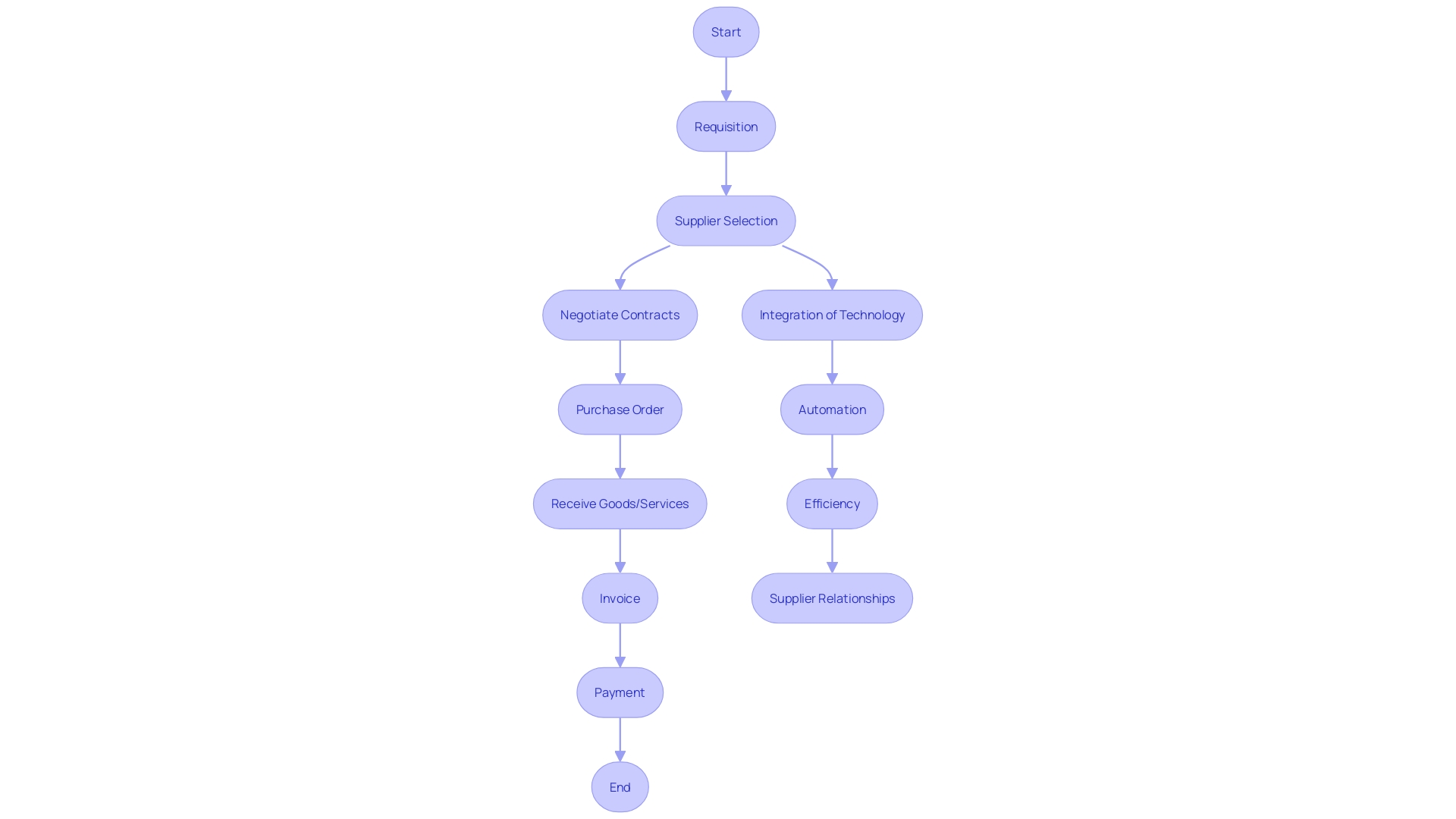
Benefits of Procure-to-Pay Automation
‘Automating the procure-to-pay workflow is a transformative measure for companies aiming to improve efficiency and productivity.’. By implementing automated workflows, businesses can significantly reduce manual errors and achieve faster processing times. This optimization not only ensures better compliance with financial regulations but also provides enhanced visibility into spending patterns.
Incorporating AI and machine learning into procurement processes can offer a competitive edge. These technologies enable organizations to leverage data analytics for informed decision-making, driving strategic value creation. As mentioned in industry reports, complete mechanization of accounts payable can stimulate business growth, enhance financial management, and result in substantial cost savings.
“Amy Raymond, Senior Vice President of Revenue Cycle Operations and Deployments at AKASA, emphasizes that ‘mechanization is no longer simply an option in the revenue cycle — it is an imperative.’ This sentiment is echoed across various sectors, where mechanization frees up staff from routine tasks, allowing them to focus on more strategic initiatives.”.
Additionally, automation in purchasing allows entities to rethink comprehensive processes, capturing full value by utilizing advanced technologies. As companies invest in developing AI-powered purchasing abilities, they set themselves up to attain enhanced efficiency and creativity. The future of acquiring goods is intelligent, data-driven, and transformative, with businesses that embrace these changes leading the way.
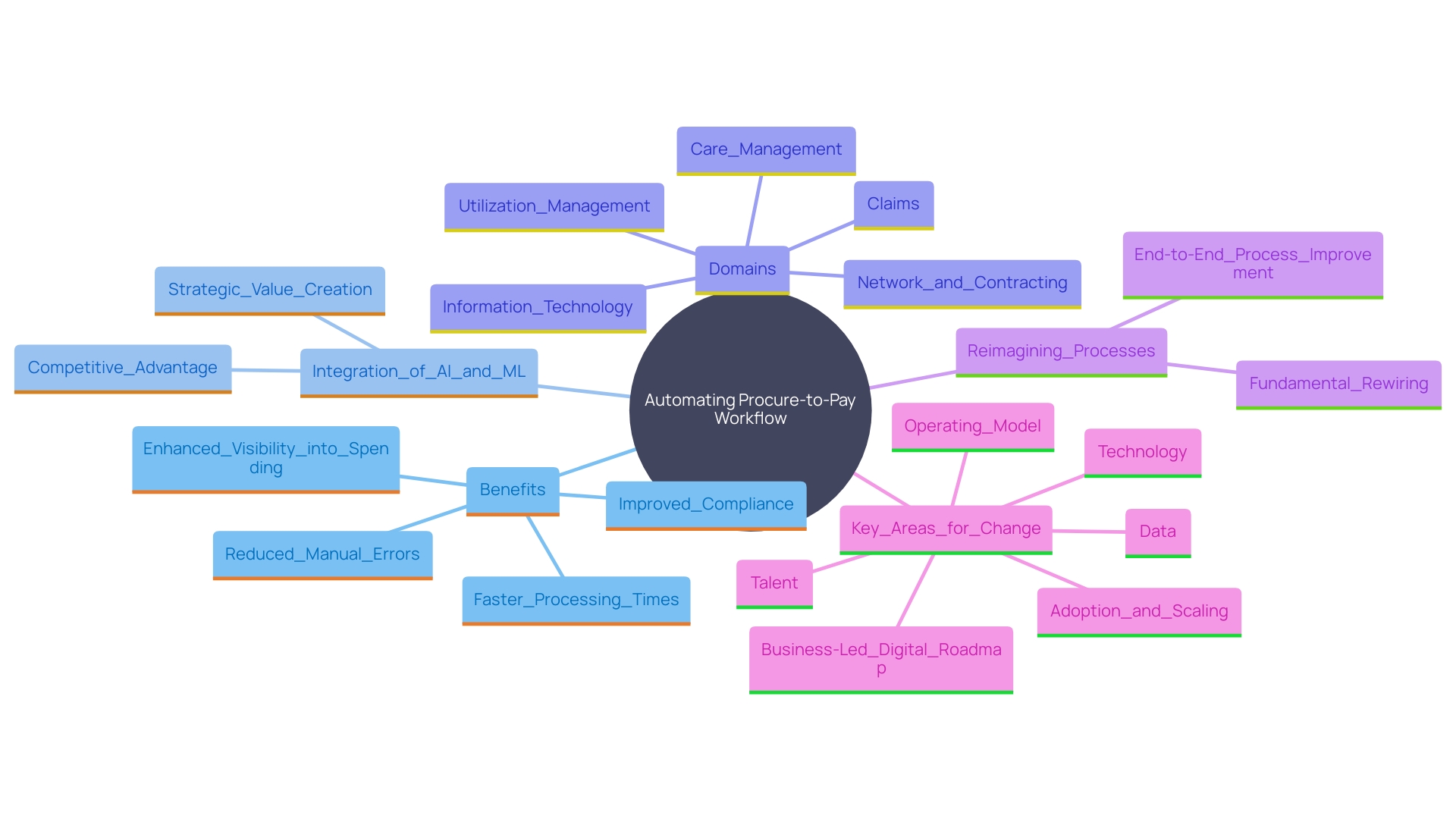
Key Steps in the Procure-to-Pay Process
-
Needs Identification and Requisitioning: The process begins with identifying the specific requirements of the entity. Employees or departments create purchase requisitions detailing the needed goods or services. These requisitions undergo an approval workflow to ensure alignment with the company’s budget and procurement policies.
-
Supplier Selection and Purchase Order Creation: Once requisitions are approved, the next step is evaluating potential suppliers. A Request for Quotation (RFQ) is issued to gather pricing, terms, and other relevant details. Suppliers submit their quotations, which are evaluated based on factors such as price, quality, and delivery time. The group then chooses the supplier providing the most advantageous conditions and creates purchase orders.
-
Goods Receipt and Verification: Upon delivery, goods or services are received and verified to ensure they meet the specified quality standards. This step is crucial in maintaining product quality and delivery performance, as evidenced by a major public sector entity that improved its product quality and delivery performance significantly.
-
Invoice Processing and Verification: Invoices received from suppliers are matched with the respective purchase orders and goods receipts for accuracy. This method ensures that the organization only pays for what was ordered and received, enhancing financial accuracy and accountability.
-
Payment Authorization and Execution: Verified invoices are then processed for payment. This step includes authorizing payments and maintaining detailed records for future audits. Automation solutions, like those offered by firms such as Basware and Coupa, simplify this task, lowering expenses and enhancing efficiency. ‘The digital transformation within procurement activities is driving the need for real-time solutions and advanced business intelligence, making this step more efficient and accurate.’.
How to Automate Your Procure-to-Pay Process
To streamline your procure-to-pay (P2P) workflow efficiently, start by choosing the appropriate tools designed for your organizational requirements. Implement a robust software solution that integrates seamlessly with your existing systems. Define your workflow meticulously to ensure every step, from requisition to payment, is automated.
Take the example of Mass General Brigham hospital system in Boston. In 2018, they faced significant inefficiencies in tracking healthcare providers. By forming a dedicated automation team and reorganizing their workflow, they developed a tool that automatically gathered and arranged provider data, drastically enhancing their system.
Training your team on the new system is crucial, as is establishing clear protocols for handling exceptions. Regularly review and refine the process for continuous improvement. As contemporary purchasing divisions have demonstrated, adopting these technologies can result in advantages such as decreased expenses, enhanced efficiencies, minimized risk, and better adherence. According to Technavio, the procurement software market is expected to grow by 10.77% annually over the next four years, reaching an additional value of $5.72 billion.
These tools not only streamline processes but also provide real-time spend analysis and reporting, which is invaluable for optimizing business spending. However, be prepared for potential challenges during initial setup and integration. Surmounting these obstacles can result in considerable competitive benefits, as illustrated by firms such as St. James Winery, which experienced greater margins and enhanced efficiency by utilizing technology.
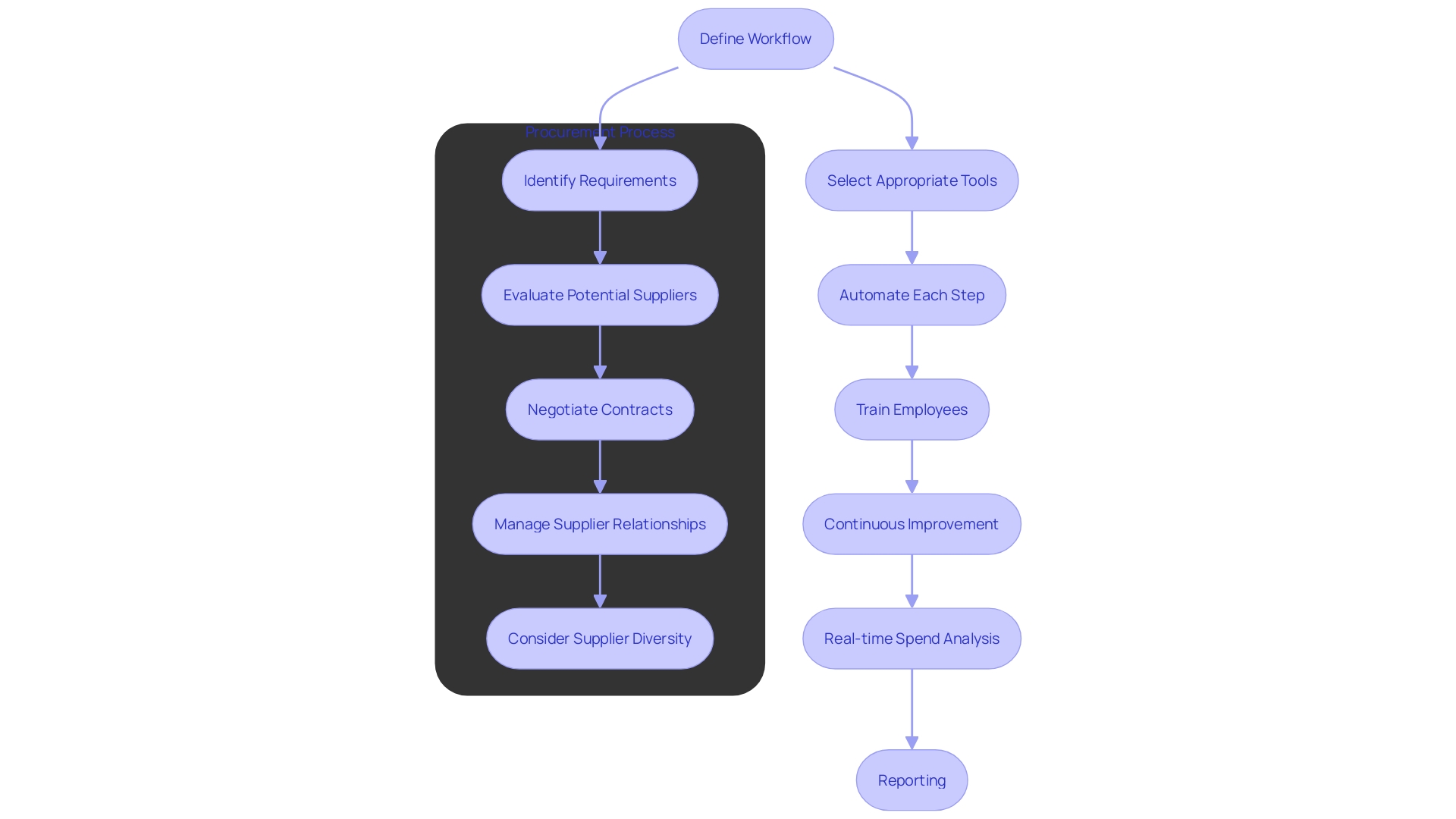
Choosing the Right Procure-to-Pay Automation Software
When selecting P2P automation software, it’s crucial to evaluate several key factors to ensure the solution aligns with your organization’s needs. Scalability is essential for growing businesses, while user-friendliness ensures ease of adoption and reduces training time. Integration capabilities with existing systems, such as accounting software, HRIS, and payment applications, are vital for seamless operations. ‘Vendor assistance and adaptability in payment conditions also play an important part, as emphasized by a recent study indicating that 22% of participants prioritize flexible payment conditions and 20% appreciate streamlined procedures.’.
Look for features like automated invoice matching, real-time reporting, and compliance management to enhance your workflows. For instance, Hyatt Hotels Corporation enhanced its procurement function by choosing BirchStreet Systems, which provided comprehensive solutions tailored to the hospitality industry. This move enabled Hyatt to improve spend visibility, control, and compliance, demonstrating the impact of well-chosen software.
Additionally, conducting demos and gathering feedback from end-users can provide valuable insights into the software’s practical application and effectiveness. Practical instances, like Hyatt’s effective execution, further highlight the significance of comprehensive assessment and user participation in the selection procedure.
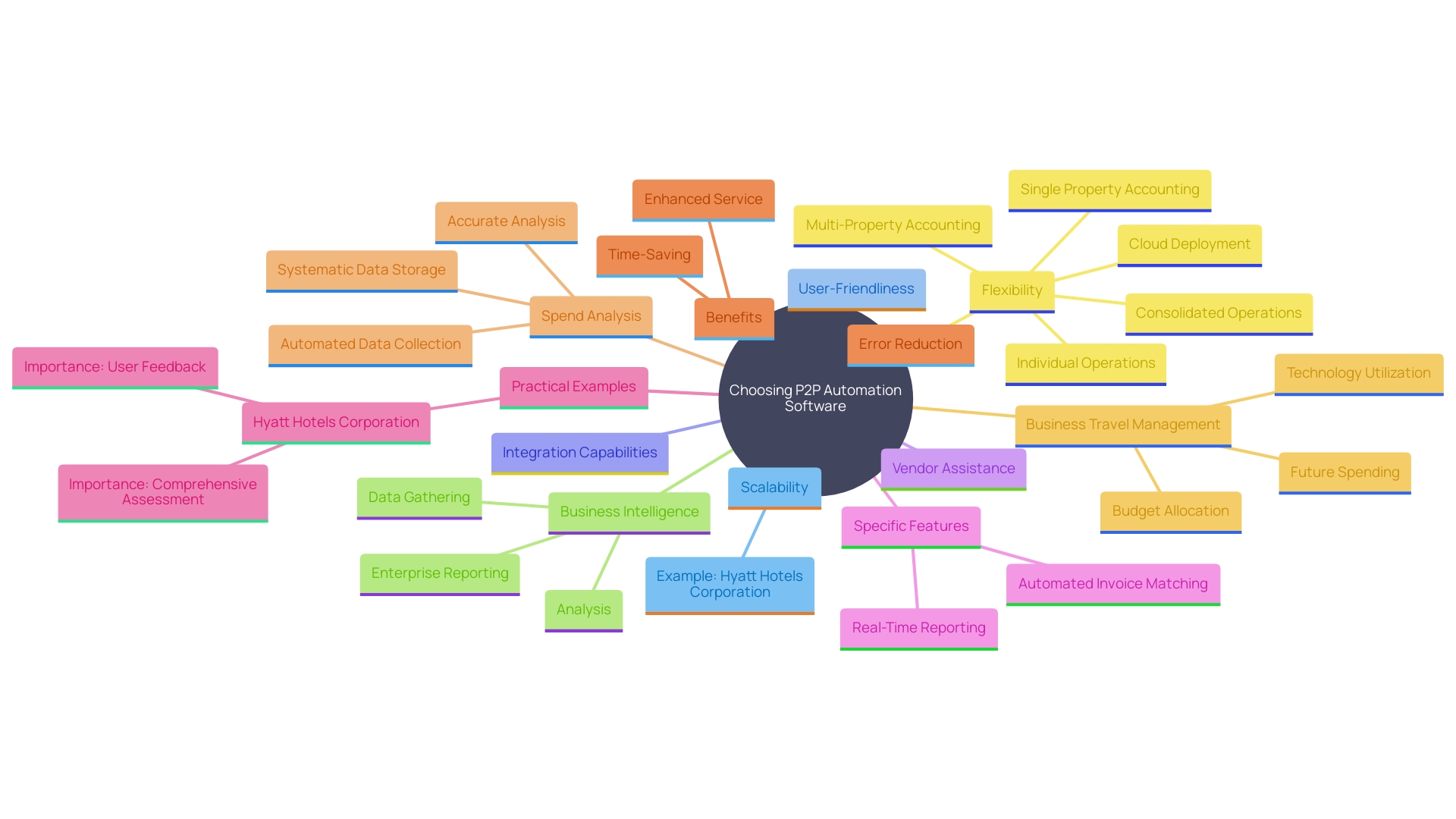
Implementing Procure-to-Pay Automation
Effective execution of P2P systemization requires a well-organized plan, starting with a pilot initiative to evaluate the systemization process in a regulated setting. This approach allows for gathering feedback and making necessary adjustments before a full-scale rollout. A notable example of this is the approach taken by Delivery Hero, a global delivery platform operating in over 70 countries. To address the challenge of employees getting locked out of their accounts, the IT service delivery team led by Dennis Zahrt implemented an automated solution. This pilot program reduced the average recovery time from 35 minutes to a mere few minutes, saving around 200 hours monthly.
Involving stakeholders from the outset is crucial in minimizing resistance to change. This guarantees that the advantages of mechanization are conveyed efficiently. As emphasized by specialists from Optum, a leader in revenue cycle management, mechanization can significantly reduce costs and improve overall operational efficiency. Moreover, the experience of companies more advanced in their technological journey shows a competitive edge, with potential net savings of 13 to 25 percent in administrative expenses and 5 to 11 percent in healthcare costs.
By adhering to these steps and learning from successful case studies, organizations can harness the full potential of P2P automation to redefine their operational methods and achieve substantial efficiency gains.
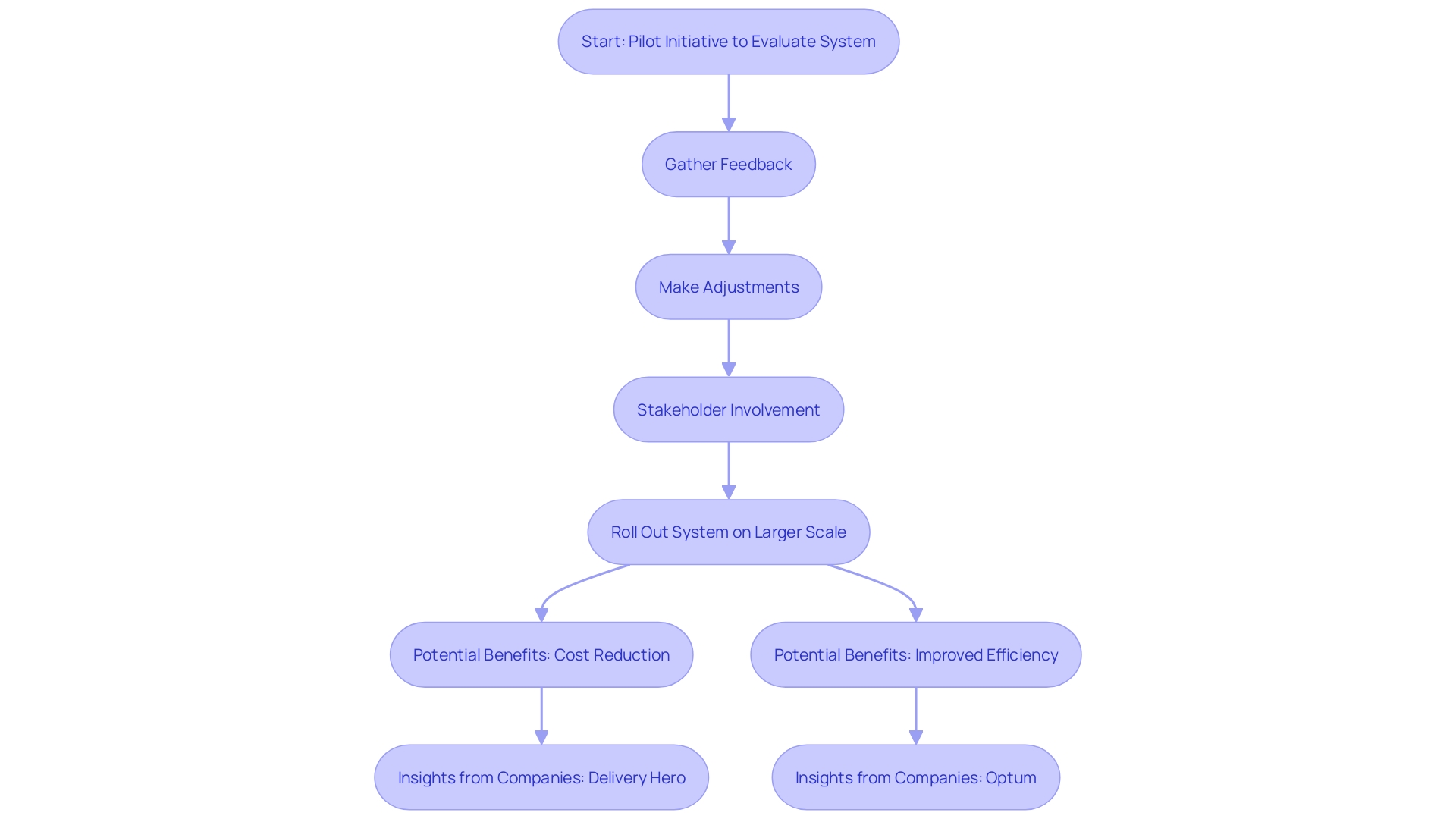
Best Practices for Procure-to-Pay Automation
‘Implementing best practices for automating healthcare and financial systems involves several key steps.’. First, establish clear policies and procedures to direct the automated system, ensuring consistency and reliability. Maintain regular and open communication with suppliers about expectations and any changes to avoid misunderstandings and disruptions.
To maximize system effectiveness, provide ongoing training and support for employees. This will help them adapt to new technologies and workflows, ultimately improving overall efficiency.
Leverage tools like dashboards, inventory trackers, and alerting systems to enhance process efficiency. For instance, dashboards can consolidate data from multiple sources, allowing managers to interpret and act on insights effectively. Alerts can notify managers of any issues that need immediate attention, ensuring prompt action.
Consistently examine data to recognize patterns, inefficiencies, and chances for additional mechanization. This examination is essential for ongoing enhancement and can uncover areas where further mechanization can lead to substantial benefits.
Incorporating robust APIs and ensuring seamless integration with existing systems can further enhance the utility of automated solutions. Companies like Basware and Coupa lead the market in providing such integrated solutions, which help streamline operations and improve data accuracy.
Alongside these technical elements, creating a robust business case is vital for obtaining funding in technological advancements. This involves quantifying potential cost savings, increased efficiency, and improved supplier relationships. Highlighting quick wins and demonstrating the platform’s value can make a compelling case for stakeholders.
Change management is another critical component. Implement a comprehensive strategy that includes clear communication, training, and ongoing support to address concerns and highlight the benefits of the new system. Effective change management can significantly reduce resistance and ensure smoother transitions.
The procurement software market is expected to grow by $5.72 billion over the next four years, driven by the need for real-time solutions and advanced business intelligence. As companies increasingly adopt these technologies, staying ahead with best practices and strategic implementations will be key to maintaining a competitive edge and achieving operational excellence.
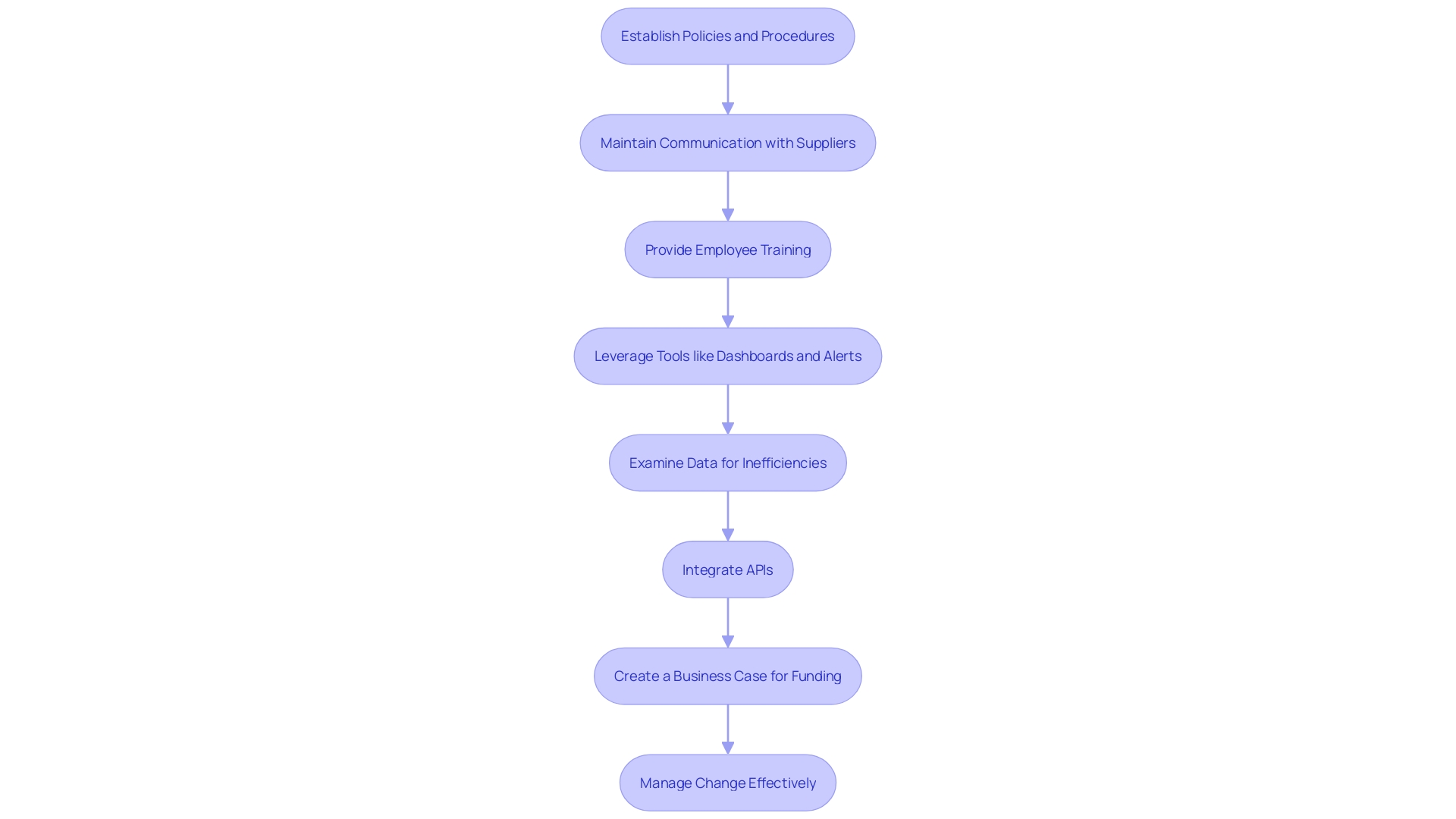
Overcoming Challenges in Procure-to-Pay Automation
Implementing P2P automation presents several challenges, such as employee resistance, integration issues, and data quality concerns. To overcome resistance, it’s crucial to involve employees early in the undertaking and provide comprehensive training. This approach not only addresses resistance but also fosters a collaborative environment, as highlighted by the successful partnership between ADP and PTC, which centralized payroll functions and streamlined processes, resulting in more accurate data for decision-making.
For seamless integration with existing systems, close collaboration with IT teams is essential. This guarantees that the tools are compatible and can function efficiently within the current infrastructure. A recent partnership between Olive Technologies and Procurify emphasizes the importance of bridging gaps between business decision-makers and procurement professionals, enhancing transparency and collaboration in tech purchasing decisions.
Regular assessment of data quality is vital. Establishing protocols for cleaning and maintaining accurate information can significantly improve operational efficiency. According to the Deloitte and Hackett Group surveys, more than 50% of Chief Procurement Officers feel overwhelmed by the increasing complexity and demands of their roles, including data management. By embracing sophisticated data handling methods, like batch processing and real-time processing, entities can optimize the advantages of mechanization and make prompt decisions.
In conclusion, addressing these common challenges in P2P automation requires a multifaceted approach involving employee engagement, seamless integration, and rigorous data quality management. By doing so, organizations can achieve significant improvements in operational efficiency and decision-making.
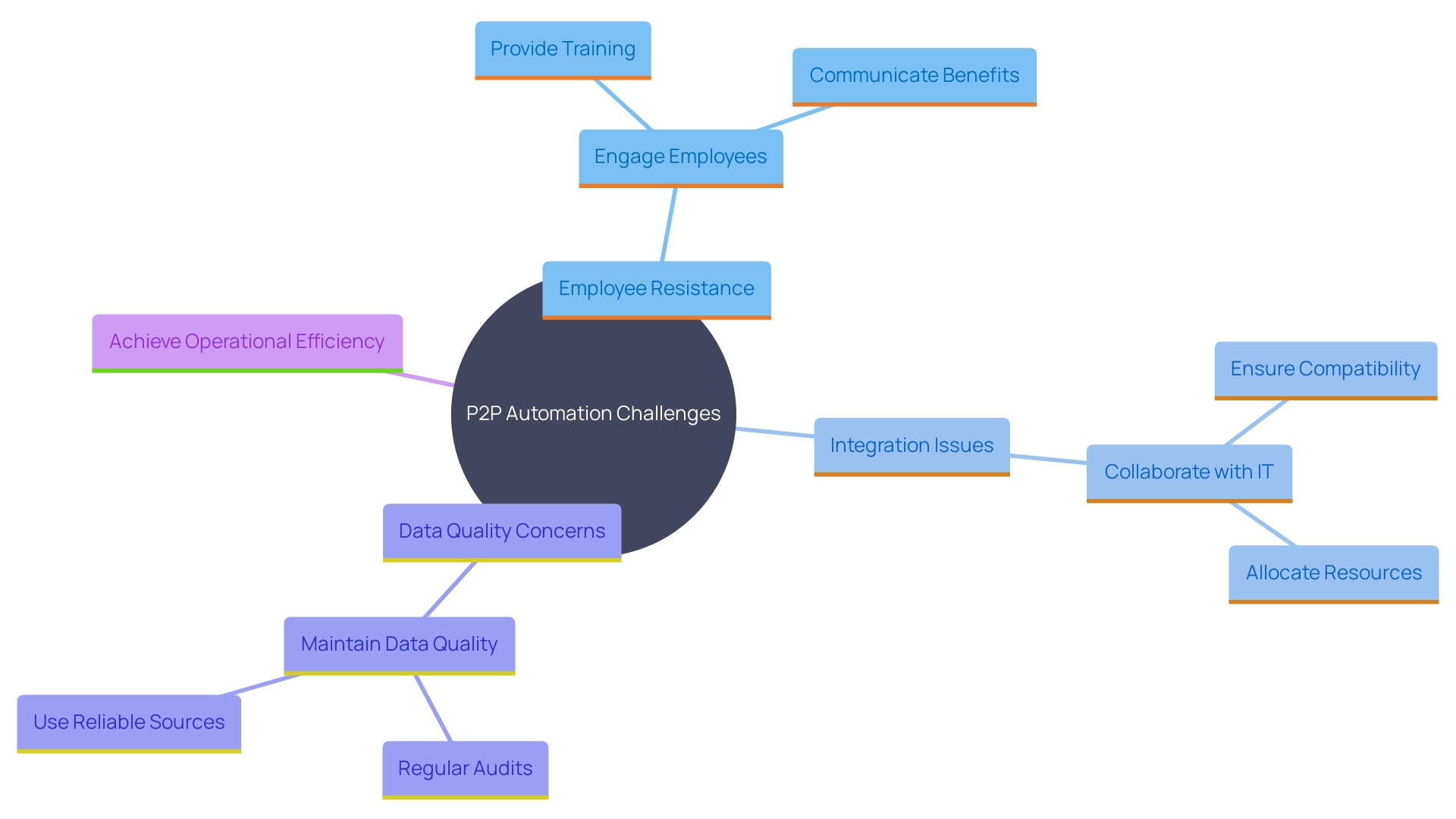
Conclusion
The procure-to-pay (P2P) process is a vital component of organizational efficiency, encompassing every step from needs identification to payment execution. By understanding and optimizing each phase of this cycle, businesses can significantly enhance cash flow management, minimize errors, and foster transparent supplier relationships. The integration of advanced technologies, particularly automation, emerges as a transformative force, streamlining workflows and offering valuable insights that drive strategic decision-making.
The benefits of P2P automation are substantial. Organizations that embrace automation can expect reduced processing times, improved compliance, and enhanced visibility into spending patterns. The incorporation of artificial intelligence and machine learning not only catalyzes business growth but also allows teams to focus on more strategic initiatives, thereby maximizing their operational potential.
However, successful implementation of automation requires careful planning and execution. Selecting the right software, establishing robust protocols, and ensuring seamless integration with existing systems are crucial steps. Organizations should also prioritize ongoing training and communication to mitigate resistance and foster a culture of collaboration.
By addressing common challenges such as data quality and employee engagement, businesses can unlock the full potential of the P2P process.
In a rapidly evolving procurement landscape, organizations that invest in best practices and innovative solutions will not only achieve operational excellence but also maintain a competitive edge. The future of procurement lies in intelligent, data-driven processes that empower organizations to thrive in an increasingly complex environment. Embracing these changes will lead to sustainable business value and enhanced supplier relationships, ensuring long-term success.

